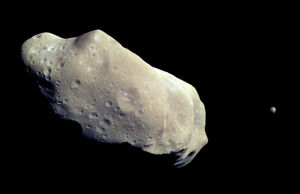| 243 Ida | |
|---|---|

| |
| Location in Solar System | In Asteroid belt |
| Discovered by | Johaan Palisa |
| Date of Discovery | September 29, 1884 |
| Place of Discovery | Vienna, Italy |
| Known Satellite(s) | Dactyl |
| Diameter | 19.6 miles 31.36 kilometers |
| Mass of Asteroid | 4.15 x 10^16 kg |
| Classification of Asteroid | S-type asteroid |
243 Ida, more commonly known as Ida, is an asteroid located in the Asteroid belt. Ida was discovered by Johann Palisa on September 29, 1884. This asteroid is about thirty six kilometers in diameter. Ida is located in the Koronis family in the Asteroid belt, a group of irregular asteroids orbiting the Sun at similar time periods.
Formation
It is believed that the Koronis group was formed from a collision of two larger celestial bodies. When the debris collided with other asteroids, larger asteroids began to form. One of them was discovered and name Ida.
Observation
On September 16, 1980, Ida was observed through a telescope for its eight-color asteroid survey or ECAS. This qualified it as an S-type asteroid, or silicate asteroid.
Exploration
The space probe, Galileo, made a flyby near Ida on August 28, 1993. This happened due to Galileo's trajectory, forcing it to travel through the Asteroid belt twice. The second time, it flew by Ida. It captured the numerous craters on the surface of Ida, even capturing a faint photograph of its moon, Dactyl.
Surface
The surface of Ida is heavily cratered. The surface is mostly colored grey, despite other features differing from this grey color due to recent creation. Regolith is shown on the surface, which is pulverized rock. The regolith is about 330 feet at its thickest. Larger boulders have been found on the surface too. These are called ejecta blocks. Some craters are larger than they appear. In fact, numerous ones have been spotted on the surface exceeding a mile, which exceeds the diameter of Dactyl. The average surface temperature is -73 degrees Celsius.
Escape Velocity
The escape velocity of a celestial object is the point at which an object reaches the least amount of speed to escape the gravitational influence of an object. A person on one of side of Ida can easily leap to the other side of Ida. If it can exceed 20 meters per second, you can easily Ida leave Ida's gravitational influence completely.
Dactyl

Dactyl is the only confirmed satellite belonging to an asteroid. Dactyl is the only known satellite belonging to the asteroid Ida. The surface and composition of Dactyl matches that of Ida closely. The surface of Dactyl is heavily cratered and contains many similar materials to Ida, yet it is not massive enough to create its own regolith. Dactyl was first photographed by the Galileo space probe in the flyby in 1993.
Surface
The surface is cratered, similar to Ida's surface. The surface is similar to that of Ida's as well, being -80 degrees Celsius. The craters on the surface of Dactyl only reach about 300 feet in diameter at the largest.
Orbit
Dactyl is believed to orbit Ida at a speed of thirty feet per second. This is extremely slow, compared to different celestial bodies in the Solar System. This is only the speed increase of falling objects of Earth each second, yet within a realm of millions of miles, this is still extremely slow. hi people
